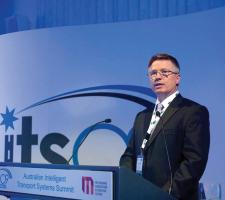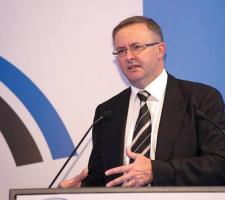
Tim Pallas called for an unambiguous, national approach which makes clear that road pricing is not just another way to get more money
Everyone in the road transport industry in Australia is talking road pricing - everyone, that is, except the politicians. Christine Keyes reports
At the end of 2008, Australia's road transport industry was wringing its collective hands, unable to raise more than $100 million from an individual bank for any Public Private Partnership (PPP). The A$750 million Peninsula Link project, announced by the Victoria Government in March 2009, was the first road project in the country to be put out to market as an availability model. It had to be, because there was no way a PPP would have gotten off the ground. It started everyone thinking: how will we pay for any new road projects or finance the maintenance backlog, conservatively estimated at A$1.5 billion per year in New South Wales alone?The Global Financial Crisis (GFC) was a catalyst for a new debate about how roads are funded in Australia.
Australia is in the fortunate position of having emerged relatively unscathed from the GFC without entering a technical recession. But the talk of road pricing for road funding remains. This was evident at the Intelligent Transport Systems Summit, held in Melbourne over 18-20 November last year. Everyone, it seems, wanted to talk about it. Except the country's politicians.
Jack Opiola, Senior Partner at D'Artagnan Consulting in Washington, DC, summed it up like this:
"I'm surprised to see this conservative attitude on the ministerial side when you're well ahead of the US on PPPs, well ahead of the US on free-flow tolling and well advanced on the technology front. All of those things are in place, yet you're behind on this issue of vehicle miles travelled.
"You have a small population and small vehicle fleet compared to the US. Why are you not more efficient?" he asked.
Broader debate
The talk about road pricing in Australia in the past has focused on congestion charging alone. But significant industry players say the time has come to broaden this debate.And the time is ripe. The Henry Review, the most significant review of Australia's taxation system since the introduction of the Goods and Services Tax (GST) in 2000, is about to be handed over to the Australian Government. The review, chaired by Secretary to the Treasury Dr Ken Henry, is expected to make recommendations supporting the introduction of road pricing in Australia.
But nervousness remains about the detail. In June 2009, A Conceptual Framework for the Reform of Taxes Related to Roads and Transport was prepared for the national Treasury. The report foreshadowed some of what could be expected in the Henry Review, but left industry leaders concerned that federal reliance on fuel excise would not be addressed:
"Arguments for hefty fuel excises do also include the role such taxes can play in substituting for more efficient road use charges that target road use costs and externalities more effectively but which are not currently in use because they currently have higher collection costs." (Clarke & Prentice 2009, p.87)
The road transport industry's peak body,
"The taxation review by Dr Ken Henry opens the way for a 'new deal' on the way Australia's transport infrastructure is funded, managed and priced. It presents an historic opportunity for generational change," says RA President, Ray Fisher.
"The cost structures for all transport users, including motorists, freight and public transport, are an accident of history.
"By and large, our roads are used as a mechanism for general taxation. Most of the revenue raised by the Commonwealth's fuel excise is spent on everything but roads," he said.
And this is indeed the 'rub': fuel excise in Australia raises over A$13.6 billion a year for the Federal Government, which goes into general revenue. Average spending on roads by the Federal Government over the 2001-2005 period was about A$2 billion per year. State governments fund the majority of roads in Australia, collectively providing around A$6 billion in capital expenditure in 2006/07.
In response to the GFC, the Federal Government has increased spending on infrastructure, including A$3.4 billion for road projects announced in the 2009/10 budget.
But as was made clear at the ITS Summit there will be a major move towards fuel-efficient vehicles in the next 10 years. As this takes place, revenue from the fuel excise will be ever-diminishing.
Federal Transport Minister Anthony Albanese stressed the importance of smart infrastructure at the summit, saying it was not the sideshow but the main event. He stopped short, however, of saying technology should be combined with road pricing in Australia to combat congestion, or indeed to fund roads.
"In Sweden, for example, an intelligent road system combined with road user charging gave Stockholm's commuters enough information to reduce traffic congestion by 22 per cent and their carbon emissions by 40 per cent," he said.
Smart infrastructure
Albanese did announce a parliamentary inquiry into smart infrastructure, which may go some way to investigating specific road pricing options that could be implemented."Similarly, we have had excellent experience in the use of microwave technology in our free-flow tollroads, as well as optical systems for enforcement.
"Perhaps our biggest challenge is managing enforcement systems away from our major city centres, given the long distances to be covered between them."
The ITS Summit concluded with a number of recommendations which were discussed in the final session with a panel of government representatives including Victorian Roads Minister Tim Pallas, VicRoads Chief Executive, Gary Liddle,
The 360 delegates who attended the two-day conference suggested that to improve road network management Australia must achieve: uniform national adoption of best practice international systems to achieve zero avoidable congestion across all modes; and a national road network that is priced, operated and used to maximise cross-modal efficiency, increase safety and reduce emissions.
More work
Victoria's Minister for Roads and Ports, Tim Pallas, agreed that the current system of pricing roads needs work."I'm not against the idea that we need a more rational system of pricing," he said.
But he also summed up the issue that faces all governments trying to introduce pricing schemes: "Governments must be unambiguously clear, with a national approach, that it [road pricing] is not just another way to get more money."
He said that communities were not ready for road pricing.
Jack Opiola is less sure about that.
"My view of Australia is it's a wonderfully open and adaptive society to change until you get to the political system and then it seems to be more British-like in holding on to the traditional views.
"And I often wonder if the politicians are actually in sync with the population," he said.
Roads Australia has commissioned one of the country's most eminent road engineers, Dr Max Lay, to write a major report on the need for change and to consider possible solutions. The report will be published early in 2010 and will call for policy collaboration between the community, industry and government in a comprehensive review. The review will address the broader issues of road funding, congestion and the environment, as part of pricing.
RA President Ray Fisher says the current system of road funding is irrational with little to recommend it.
"It's unreasonable, unjust and fails to take account of new demands, especially in terms of the environment," he said.
Apart from political will, and in many ways connected to it, is the issue of public acceptance. Philip Davies, Industry Director - Planning & Advisory at AECOM in Australia, was involved in establishing the London Congestion Charge at
"Taking the public on the journey is key," he said.
"Public acceptance that something needs to be different is important. London got to a stage that business put pressure on government. We don't want to wait for that. The Henry tax review helps to paint an image of a different way of paying for road use."
He and Jack Opiola agree that Australia is most suited to a vehicle miles travelled system similar to that being implemented in the Netherlands. Drivers pay for what they use, with time of day adjustments to address congestion during peak times.
Norm Pidgeon said that area charging or HOT lanes may work in Australia in the short term to reduce congestion, but more is needed.
"In the longer term," he continued, "a more universal regional scheme can reflect the value of access to each level of the road network and become a fairer way of reflecting the underlying cost of each journey.
"In my view, some form of road pricing is critical to providing efficient access to an increasingly stressed infrastructure."
The first steps down this path have already been taken with the National Transport Commission (NTC) and the Council of Australian Governments (COAG) Road Reform Project investigating road pricing options for freight.
But for now we wait. The Henry Review will almost certainly recommend that some form of road pricing be adopted nationally. The question is, will any Australian Government, Federal or State, be willing to implement it?













